In-Depth Analysis of Demographic Transition Model Dynamics
VerifiedAdded on 2023/05/29
|10
|2046
|176
Homework Assignment
AI Summary
This assignment delves into the Demographic Transition Model, mathematically representing population changes and analyzing birth and death rates. It examines the generalized mathematical function for population change, differentiating it to explore the relationship between birth and death rates over time. The analysis includes calculations for India and South Korea between 1985 and 2010, interpreting the significance of positive values in population change. Furthermore, the assignment identifies Stage 2 as the phase with the largest population change due to high birth rates and falling death rates, supported by mathematical explanations. The document concludes by emphasizing the conditions for population stability and instability within the model.
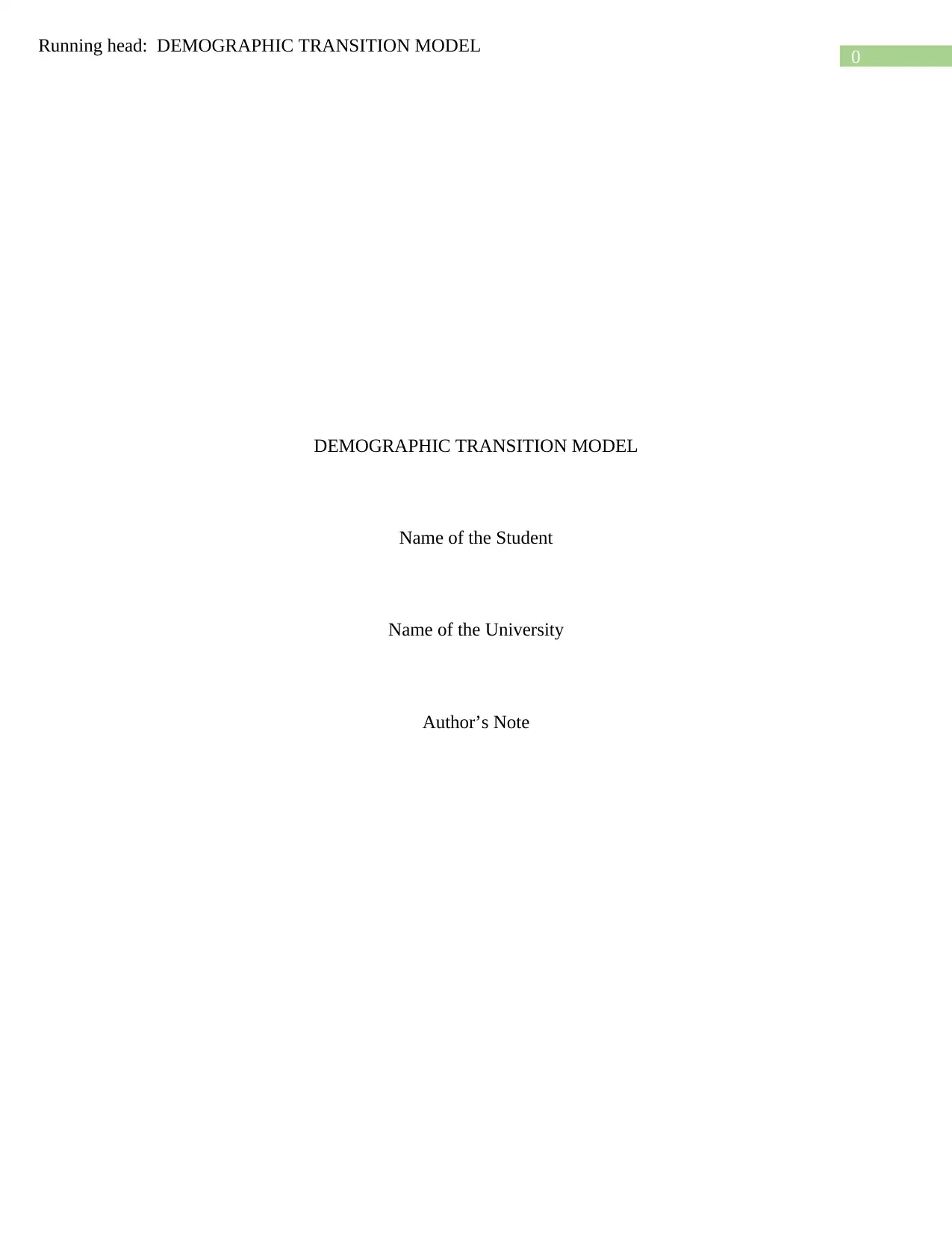
0
Running head: DEMOGRAPHIC TRANSITION MODEL
DEMOGRAPHIC TRANSITION MODEL
Name of the Student
Name of the University
Author’s Note
Running head: DEMOGRAPHIC TRANSITION MODEL
DEMOGRAPHIC TRANSITION MODEL
Name of the Student
Name of the University
Author’s Note
Paraphrase This Document
Need a fresh take? Get an instant paraphrase of this document with our AI Paraphraser
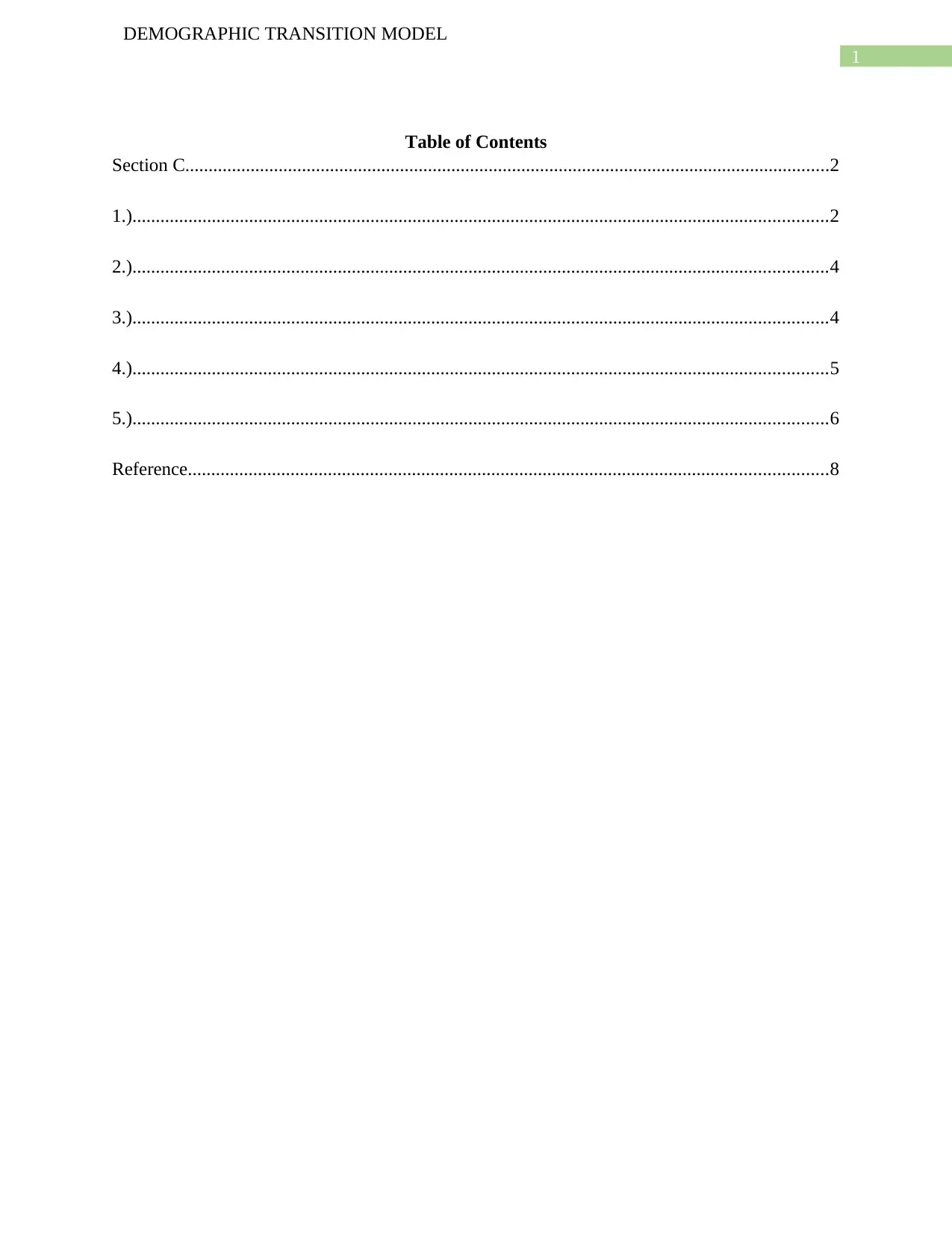
1
DEMOGRAPHIC TRANSITION MODEL
Table of Contents
Section C..........................................................................................................................................2
1.).....................................................................................................................................................2
2.).....................................................................................................................................................4
3.).....................................................................................................................................................4
4.).....................................................................................................................................................5
5.).....................................................................................................................................................6
Reference.........................................................................................................................................8
DEMOGRAPHIC TRANSITION MODEL
Table of Contents
Section C..........................................................................................................................................2
1.).....................................................................................................................................................2
2.).....................................................................................................................................................4
3.).....................................................................................................................................................4
4.).....................................................................................................................................................5
5.).....................................................................................................................................................6
Reference.........................................................................................................................................8
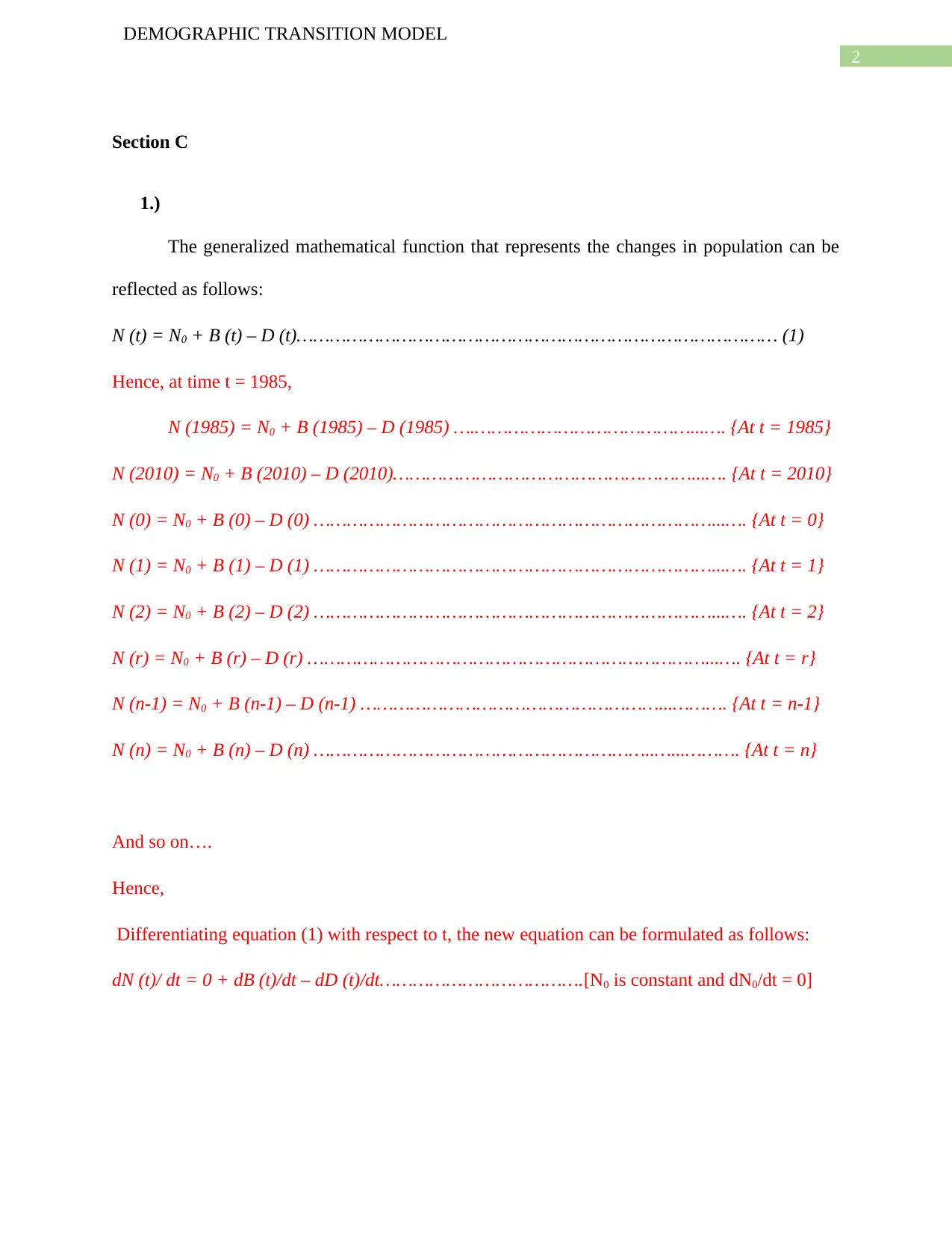
2
DEMOGRAPHIC TRANSITION MODEL
Section C
1.)
The generalized mathematical function that represents the changes in population can be
reflected as follows:
N (t) = N0 + B (t) – D (t)…………………………………………………………………………… (1)
Hence, at time t = 1985,
N (1985) = N0 + B (1985) – D (1985) ….…………………………………...…. {At t = 1985}
N (2010) = N0 + B (2010) – D (2010)………………………………………………...…. {At t = 2010}
N (0) = N0 + B (0) – D (0) ………………………………………………………………...…. {At t = 0}
N (1) = N0 + B (1) – D (1) ………………………………………………………………...…. {At t = 1}
N (2) = N0 + B (2) – D (2) ………………………………………………………………...…. {At t = 2}
N (r) = N0 + B (r) – D (r) ………………………………………………………………...…. {At t = r}
N (n-1) = N0 + B (n-1) – D (n-1) ………………………………………………...………. {At t = n-1}
N (n) = N0 + B (n) – D (n) ……………………………………………………..…...………. {At t = n}
And so on….
Hence,
Differentiating equation (1) with respect to t, the new equation can be formulated as follows:
dN (t)/ dt = 0 + dB (t)/dt – dD (t)/dt……………………………….[N0 is constant and dN0/dt = 0]
DEMOGRAPHIC TRANSITION MODEL
Section C
1.)
The generalized mathematical function that represents the changes in population can be
reflected as follows:
N (t) = N0 + B (t) – D (t)…………………………………………………………………………… (1)
Hence, at time t = 1985,
N (1985) = N0 + B (1985) – D (1985) ….…………………………………...…. {At t = 1985}
N (2010) = N0 + B (2010) – D (2010)………………………………………………...…. {At t = 2010}
N (0) = N0 + B (0) – D (0) ………………………………………………………………...…. {At t = 0}
N (1) = N0 + B (1) – D (1) ………………………………………………………………...…. {At t = 1}
N (2) = N0 + B (2) – D (2) ………………………………………………………………...…. {At t = 2}
N (r) = N0 + B (r) – D (r) ………………………………………………………………...…. {At t = r}
N (n-1) = N0 + B (n-1) – D (n-1) ………………………………………………...………. {At t = n-1}
N (n) = N0 + B (n) – D (n) ……………………………………………………..…...………. {At t = n}
And so on….
Hence,
Differentiating equation (1) with respect to t, the new equation can be formulated as follows:
dN (t)/ dt = 0 + dB (t)/dt – dD (t)/dt……………………………….[N0 is constant and dN0/dt = 0]
⊘ This is a preview!⊘
Do you want full access?
Subscribe today to unlock all pages.

Trusted by 1+ million students worldwide
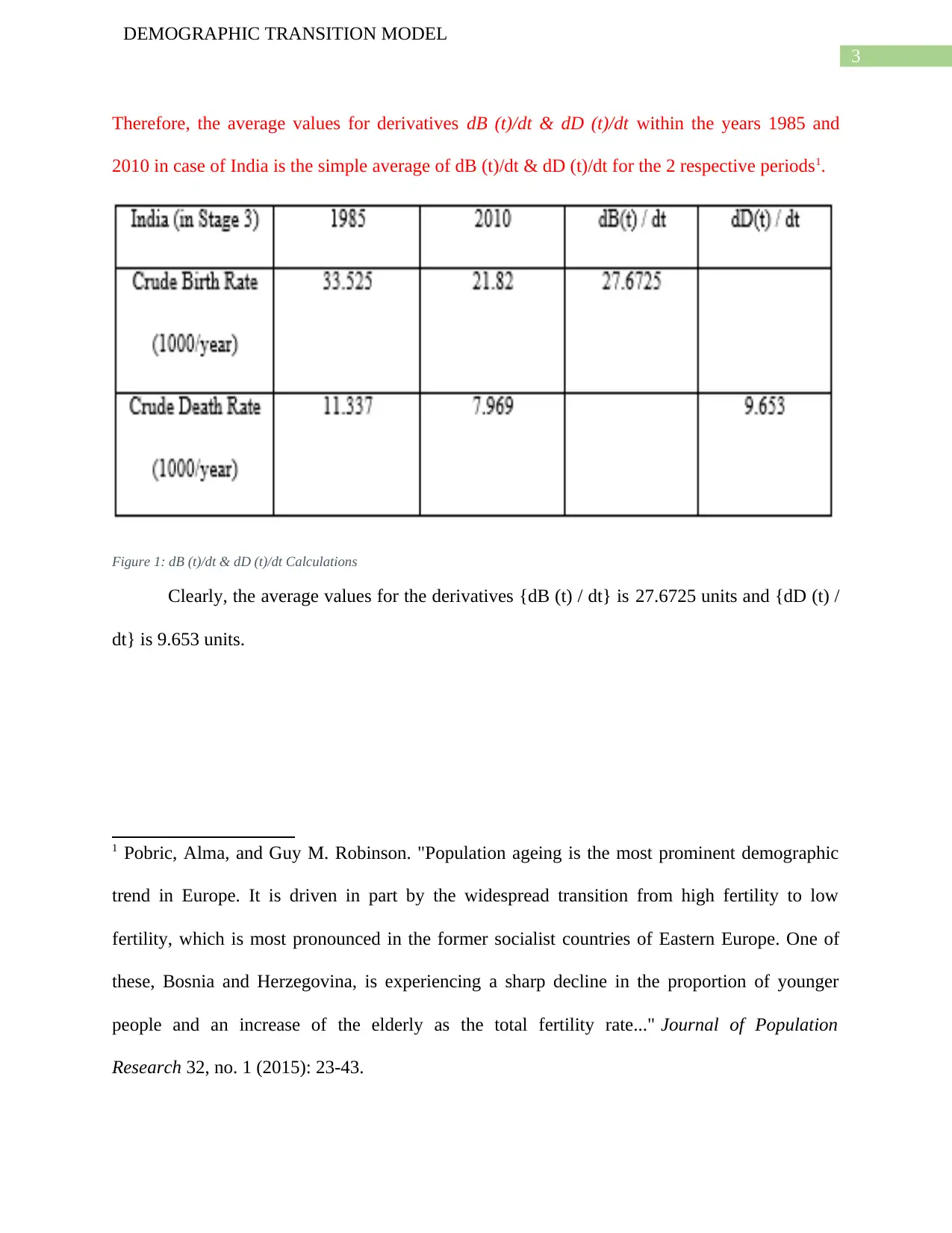
3
DEMOGRAPHIC TRANSITION MODEL
Therefore, the average values for derivatives dB (t)/dt & dD (t)/dt within the years 1985 and
2010 in case of India is the simple average of dB (t)/dt & dD (t)/dt for the 2 respective periods1.
Figure 1: dB (t)/dt & dD (t)/dt Calculations
Clearly, the average values for the derivatives {dB (t) / dt} is 27.6725 units and {dD (t) /
dt} is 9.653 units.
1 Pobric, Alma, and Guy M. Robinson. "Population ageing is the most prominent demographic
trend in Europe. It is driven in part by the widespread transition from high fertility to low
fertility, which is most pronounced in the former socialist countries of Eastern Europe. One of
these, Bosnia and Herzegovina, is experiencing a sharp decline in the proportion of younger
people and an increase of the elderly as the total fertility rate..." Journal of Population
Research 32, no. 1 (2015): 23-43.
DEMOGRAPHIC TRANSITION MODEL
Therefore, the average values for derivatives dB (t)/dt & dD (t)/dt within the years 1985 and
2010 in case of India is the simple average of dB (t)/dt & dD (t)/dt for the 2 respective periods1.
Figure 1: dB (t)/dt & dD (t)/dt Calculations
Clearly, the average values for the derivatives {dB (t) / dt} is 27.6725 units and {dD (t) /
dt} is 9.653 units.
1 Pobric, Alma, and Guy M. Robinson. "Population ageing is the most prominent demographic
trend in Europe. It is driven in part by the widespread transition from high fertility to low
fertility, which is most pronounced in the former socialist countries of Eastern Europe. One of
these, Bosnia and Herzegovina, is experiencing a sharp decline in the proportion of younger
people and an increase of the elderly as the total fertility rate..." Journal of Population
Research 32, no. 1 (2015): 23-43.
Paraphrase This Document
Need a fresh take? Get an instant paraphrase of this document with our AI Paraphraser
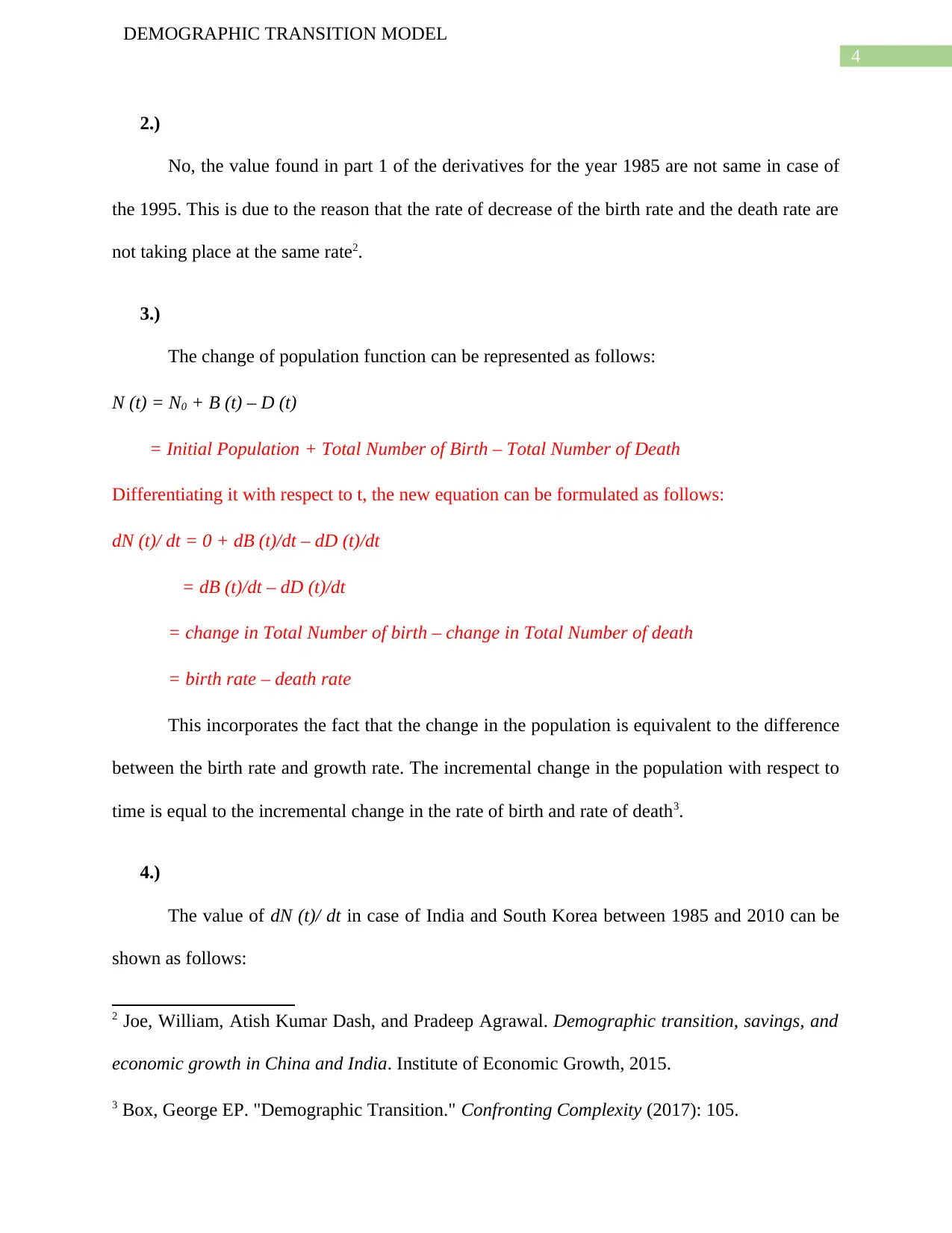
4
DEMOGRAPHIC TRANSITION MODEL
2.)
No, the value found in part 1 of the derivatives for the year 1985 are not same in case of
the 1995. This is due to the reason that the rate of decrease of the birth rate and the death rate are
not taking place at the same rate2.
3.)
The change of population function can be represented as follows:
N (t) = N0 + B (t) – D (t)
= Initial Population + Total Number of Birth – Total Number of Death
Differentiating it with respect to t, the new equation can be formulated as follows:
dN (t)/ dt = 0 + dB (t)/dt – dD (t)/dt
= dB (t)/dt – dD (t)/dt
= change in Total Number of birth – change in Total Number of death
= birth rate – death rate
This incorporates the fact that the change in the population is equivalent to the difference
between the birth rate and growth rate. The incremental change in the population with respect to
time is equal to the incremental change in the rate of birth and rate of death3.
4.)
The value of dN (t)/ dt in case of India and South Korea between 1985 and 2010 can be
shown as follows:
2 Joe, William, Atish Kumar Dash, and Pradeep Agrawal. Demographic transition, savings, and
economic growth in China and India. Institute of Economic Growth, 2015.
3 Box, George EP. "Demographic Transition." Confronting Complexity (2017): 105.
DEMOGRAPHIC TRANSITION MODEL
2.)
No, the value found in part 1 of the derivatives for the year 1985 are not same in case of
the 1995. This is due to the reason that the rate of decrease of the birth rate and the death rate are
not taking place at the same rate2.
3.)
The change of population function can be represented as follows:
N (t) = N0 + B (t) – D (t)
= Initial Population + Total Number of Birth – Total Number of Death
Differentiating it with respect to t, the new equation can be formulated as follows:
dN (t)/ dt = 0 + dB (t)/dt – dD (t)/dt
= dB (t)/dt – dD (t)/dt
= change in Total Number of birth – change in Total Number of death
= birth rate – death rate
This incorporates the fact that the change in the population is equivalent to the difference
between the birth rate and growth rate. The incremental change in the population with respect to
time is equal to the incremental change in the rate of birth and rate of death3.
4.)
The value of dN (t)/ dt in case of India and South Korea between 1985 and 2010 can be
shown as follows:
2 Joe, William, Atish Kumar Dash, and Pradeep Agrawal. Demographic transition, savings, and
economic growth in China and India. Institute of Economic Growth, 2015.
3 Box, George EP. "Demographic Transition." Confronting Complexity (2017): 105.
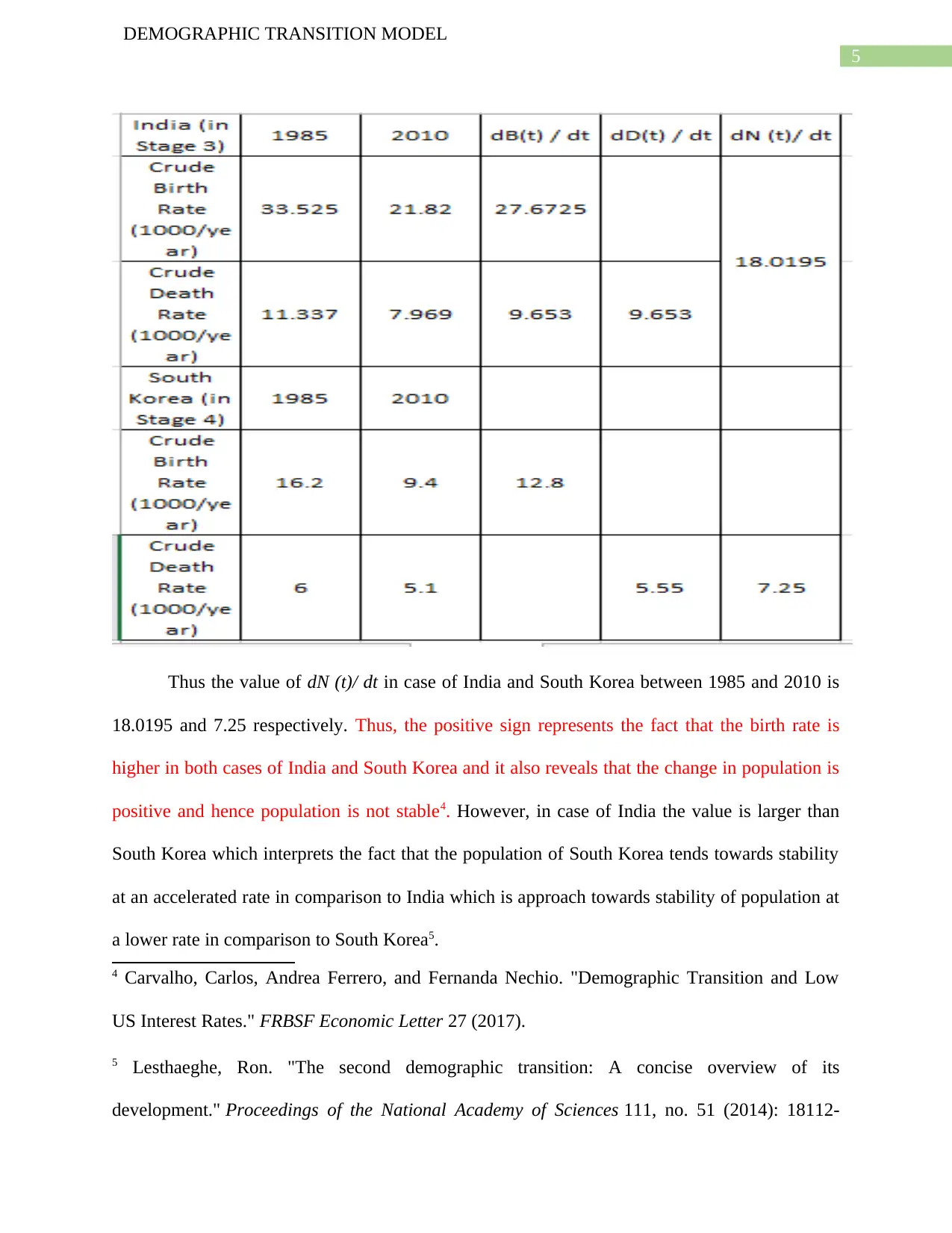
5
DEMOGRAPHIC TRANSITION MODEL
Thus the value of dN (t)/ dt in case of India and South Korea between 1985 and 2010 is
18.0195 and 7.25 respectively. Thus, the positive sign represents the fact that the birth rate is
higher in both cases of India and South Korea and it also reveals that the change in population is
positive and hence population is not stable4. However, in case of India the value is larger than
South Korea which interprets the fact that the population of South Korea tends towards stability
at an accelerated rate in comparison to India which is approach towards stability of population at
a lower rate in comparison to South Korea5.
4 Carvalho, Carlos, Andrea Ferrero, and Fernanda Nechio. "Demographic Transition and Low
US Interest Rates." FRBSF Economic Letter 27 (2017).
5 Lesthaeghe, Ron. "The second demographic transition: A concise overview of its
development." Proceedings of the National Academy of Sciences 111, no. 51 (2014): 18112-
DEMOGRAPHIC TRANSITION MODEL
Thus the value of dN (t)/ dt in case of India and South Korea between 1985 and 2010 is
18.0195 and 7.25 respectively. Thus, the positive sign represents the fact that the birth rate is
higher in both cases of India and South Korea and it also reveals that the change in population is
positive and hence population is not stable4. However, in case of India the value is larger than
South Korea which interprets the fact that the population of South Korea tends towards stability
at an accelerated rate in comparison to India which is approach towards stability of population at
a lower rate in comparison to South Korea5.
4 Carvalho, Carlos, Andrea Ferrero, and Fernanda Nechio. "Demographic Transition and Low
US Interest Rates." FRBSF Economic Letter 27 (2017).
5 Lesthaeghe, Ron. "The second demographic transition: A concise overview of its
development." Proceedings of the National Academy of Sciences 111, no. 51 (2014): 18112-
⊘ This is a preview!⊘
Do you want full access?
Subscribe today to unlock all pages.

Trusted by 1+ million students worldwide
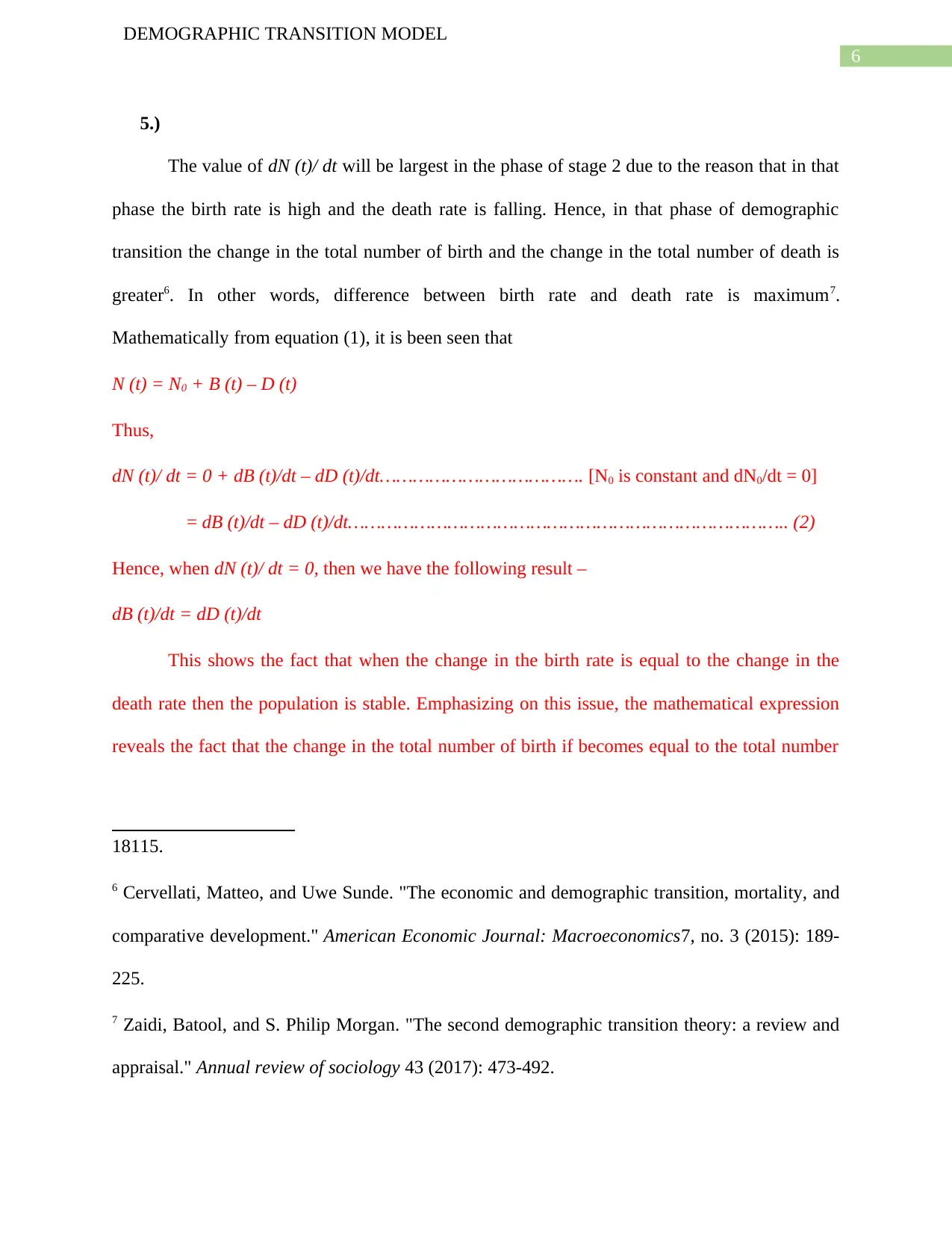
6
DEMOGRAPHIC TRANSITION MODEL
5.)
The value of dN (t)/ dt will be largest in the phase of stage 2 due to the reason that in that
phase the birth rate is high and the death rate is falling. Hence, in that phase of demographic
transition the change in the total number of birth and the change in the total number of death is
greater6. In other words, difference between birth rate and death rate is maximum7.
Mathematically from equation (1), it is been seen that
N (t) = N0 + B (t) – D (t)
Thus,
dN (t)/ dt = 0 + dB (t)/dt – dD (t)/dt………………………………. [N0 is constant and dN0/dt = 0]
= dB (t)/dt – dD (t)/dt…………………………………………………………………….. (2)
Hence, when dN (t)/ dt = 0, then we have the following result –
dB (t)/dt = dD (t)/dt
This shows the fact that when the change in the birth rate is equal to the change in the
death rate then the population is stable. Emphasizing on this issue, the mathematical expression
reveals the fact that the change in the total number of birth if becomes equal to the total number
18115.
6 Cervellati, Matteo, and Uwe Sunde. "The economic and demographic transition, mortality, and
comparative development." American Economic Journal: Macroeconomics7, no. 3 (2015): 189-
225.
7 Zaidi, Batool, and S. Philip Morgan. "The second demographic transition theory: a review and
appraisal." Annual review of sociology 43 (2017): 473-492.
DEMOGRAPHIC TRANSITION MODEL
5.)
The value of dN (t)/ dt will be largest in the phase of stage 2 due to the reason that in that
phase the birth rate is high and the death rate is falling. Hence, in that phase of demographic
transition the change in the total number of birth and the change in the total number of death is
greater6. In other words, difference between birth rate and death rate is maximum7.
Mathematically from equation (1), it is been seen that
N (t) = N0 + B (t) – D (t)
Thus,
dN (t)/ dt = 0 + dB (t)/dt – dD (t)/dt………………………………. [N0 is constant and dN0/dt = 0]
= dB (t)/dt – dD (t)/dt…………………………………………………………………….. (2)
Hence, when dN (t)/ dt = 0, then we have the following result –
dB (t)/dt = dD (t)/dt
This shows the fact that when the change in the birth rate is equal to the change in the
death rate then the population is stable. Emphasizing on this issue, the mathematical expression
reveals the fact that the change in the total number of birth if becomes equal to the total number
18115.
6 Cervellati, Matteo, and Uwe Sunde. "The economic and demographic transition, mortality, and
comparative development." American Economic Journal: Macroeconomics7, no. 3 (2015): 189-
225.
7 Zaidi, Batool, and S. Philip Morgan. "The second demographic transition theory: a review and
appraisal." Annual review of sociology 43 (2017): 473-492.
Paraphrase This Document
Need a fresh take? Get an instant paraphrase of this document with our AI Paraphraser
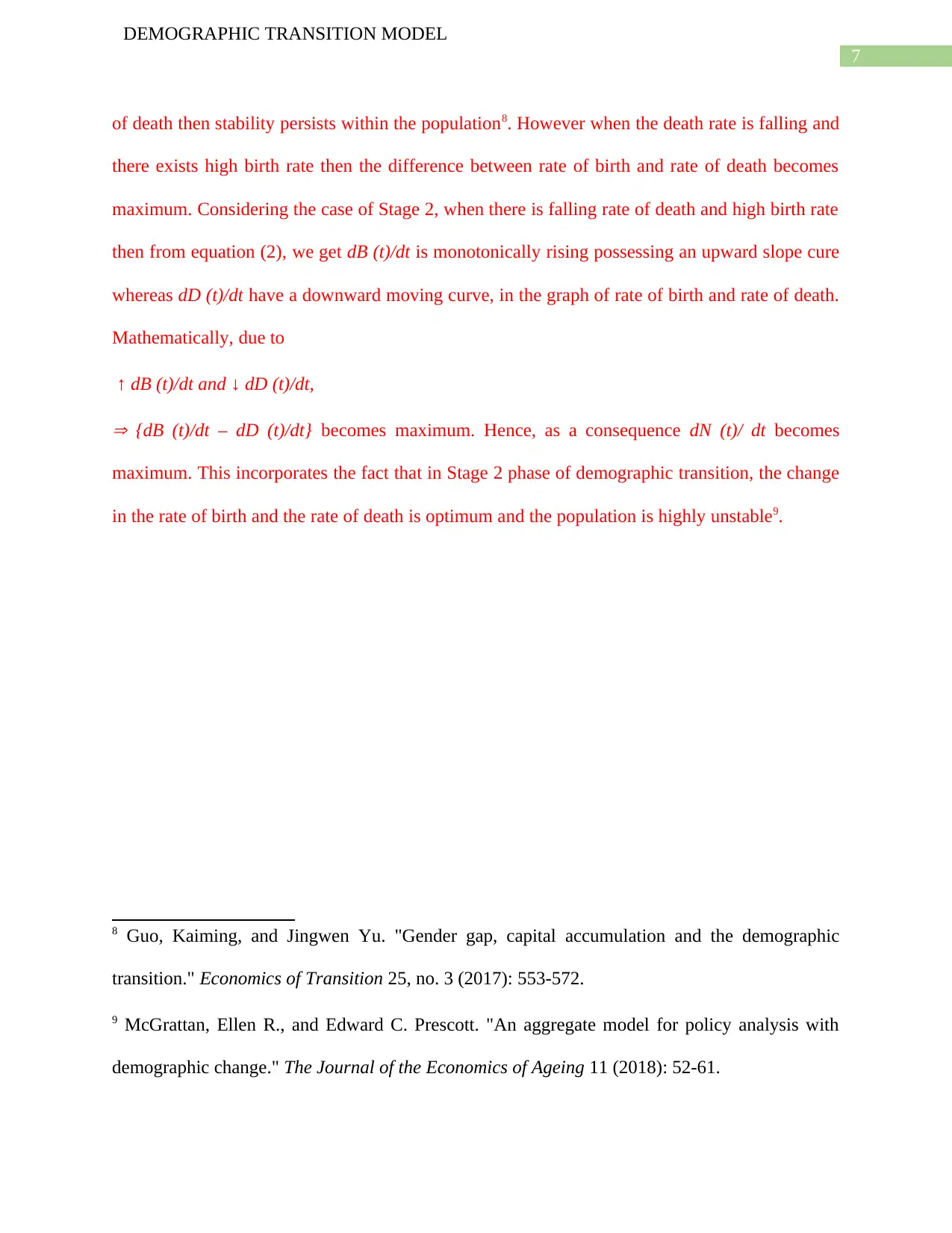
7
DEMOGRAPHIC TRANSITION MODEL
of death then stability persists within the population8. However when the death rate is falling and
there exists high birth rate then the difference between rate of birth and rate of death becomes
maximum. Considering the case of Stage 2, when there is falling rate of death and high birth rate
then from equation (2), we get dB (t)/dt is monotonically rising possessing an upward slope cure
whereas dD (t)/dt have a downward moving curve, in the graph of rate of birth and rate of death.
Mathematically, due to
↑ dB (t)/dt and ↓ dD (t)/dt,
{dB (t)/dt – dD (t)/dt} becomes maximum. Hence, as a consequence dN (t)/ dt becomes
maximum. This incorporates the fact that in Stage 2 phase of demographic transition, the change
in the rate of birth and the rate of death is optimum and the population is highly unstable9.
8 Guo, Kaiming, and Jingwen Yu. "Gender gap, capital accumulation and the demographic
transition." Economics of Transition 25, no. 3 (2017): 553-572.
9 McGrattan, Ellen R., and Edward C. Prescott. "An aggregate model for policy analysis with
demographic change." The Journal of the Economics of Ageing 11 (2018): 52-61.
DEMOGRAPHIC TRANSITION MODEL
of death then stability persists within the population8. However when the death rate is falling and
there exists high birth rate then the difference between rate of birth and rate of death becomes
maximum. Considering the case of Stage 2, when there is falling rate of death and high birth rate
then from equation (2), we get dB (t)/dt is monotonically rising possessing an upward slope cure
whereas dD (t)/dt have a downward moving curve, in the graph of rate of birth and rate of death.
Mathematically, due to
↑ dB (t)/dt and ↓ dD (t)/dt,
{dB (t)/dt – dD (t)/dt} becomes maximum. Hence, as a consequence dN (t)/ dt becomes
maximum. This incorporates the fact that in Stage 2 phase of demographic transition, the change
in the rate of birth and the rate of death is optimum and the population is highly unstable9.
8 Guo, Kaiming, and Jingwen Yu. "Gender gap, capital accumulation and the demographic
transition." Economics of Transition 25, no. 3 (2017): 553-572.
9 McGrattan, Ellen R., and Edward C. Prescott. "An aggregate model for policy analysis with
demographic change." The Journal of the Economics of Ageing 11 (2018): 52-61.
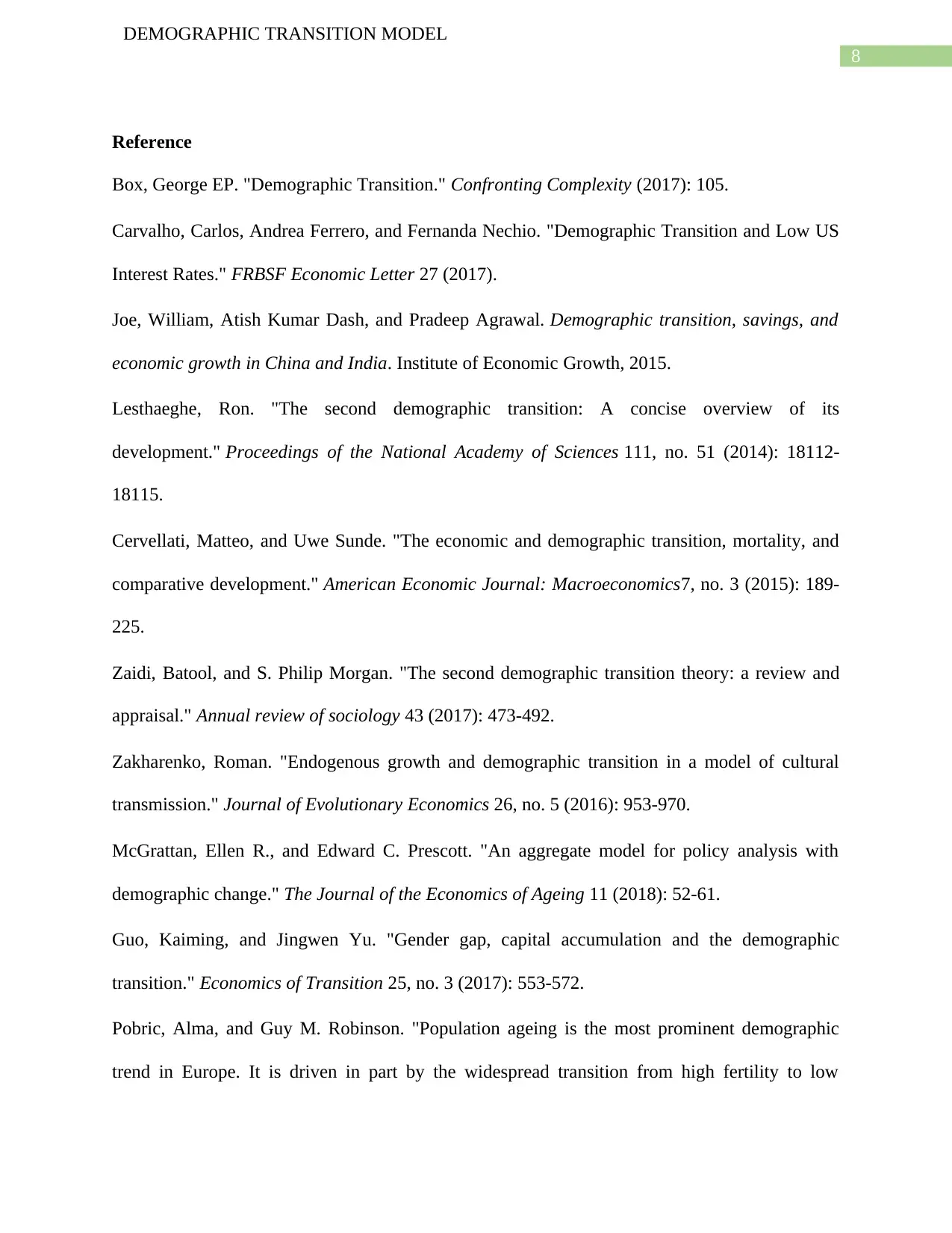
8
DEMOGRAPHIC TRANSITION MODEL
Reference
Box, George EP. "Demographic Transition." Confronting Complexity (2017): 105.
Carvalho, Carlos, Andrea Ferrero, and Fernanda Nechio. "Demographic Transition and Low US
Interest Rates." FRBSF Economic Letter 27 (2017).
Joe, William, Atish Kumar Dash, and Pradeep Agrawal. Demographic transition, savings, and
economic growth in China and India. Institute of Economic Growth, 2015.
Lesthaeghe, Ron. "The second demographic transition: A concise overview of its
development." Proceedings of the National Academy of Sciences 111, no. 51 (2014): 18112-
18115.
Cervellati, Matteo, and Uwe Sunde. "The economic and demographic transition, mortality, and
comparative development." American Economic Journal: Macroeconomics7, no. 3 (2015): 189-
225.
Zaidi, Batool, and S. Philip Morgan. "The second demographic transition theory: a review and
appraisal." Annual review of sociology 43 (2017): 473-492.
Zakharenko, Roman. "Endogenous growth and demographic transition in a model of cultural
transmission." Journal of Evolutionary Economics 26, no. 5 (2016): 953-970.
McGrattan, Ellen R., and Edward C. Prescott. "An aggregate model for policy analysis with
demographic change." The Journal of the Economics of Ageing 11 (2018): 52-61.
Guo, Kaiming, and Jingwen Yu. "Gender gap, capital accumulation and the demographic
transition." Economics of Transition 25, no. 3 (2017): 553-572.
Pobric, Alma, and Guy M. Robinson. "Population ageing is the most prominent demographic
trend in Europe. It is driven in part by the widespread transition from high fertility to low
DEMOGRAPHIC TRANSITION MODEL
Reference
Box, George EP. "Demographic Transition." Confronting Complexity (2017): 105.
Carvalho, Carlos, Andrea Ferrero, and Fernanda Nechio. "Demographic Transition and Low US
Interest Rates." FRBSF Economic Letter 27 (2017).
Joe, William, Atish Kumar Dash, and Pradeep Agrawal. Demographic transition, savings, and
economic growth in China and India. Institute of Economic Growth, 2015.
Lesthaeghe, Ron. "The second demographic transition: A concise overview of its
development." Proceedings of the National Academy of Sciences 111, no. 51 (2014): 18112-
18115.
Cervellati, Matteo, and Uwe Sunde. "The economic and demographic transition, mortality, and
comparative development." American Economic Journal: Macroeconomics7, no. 3 (2015): 189-
225.
Zaidi, Batool, and S. Philip Morgan. "The second demographic transition theory: a review and
appraisal." Annual review of sociology 43 (2017): 473-492.
Zakharenko, Roman. "Endogenous growth and demographic transition in a model of cultural
transmission." Journal of Evolutionary Economics 26, no. 5 (2016): 953-970.
McGrattan, Ellen R., and Edward C. Prescott. "An aggregate model for policy analysis with
demographic change." The Journal of the Economics of Ageing 11 (2018): 52-61.
Guo, Kaiming, and Jingwen Yu. "Gender gap, capital accumulation and the demographic
transition." Economics of Transition 25, no. 3 (2017): 553-572.
Pobric, Alma, and Guy M. Robinson. "Population ageing is the most prominent demographic
trend in Europe. It is driven in part by the widespread transition from high fertility to low
⊘ This is a preview!⊘
Do you want full access?
Subscribe today to unlock all pages.

Trusted by 1+ million students worldwide
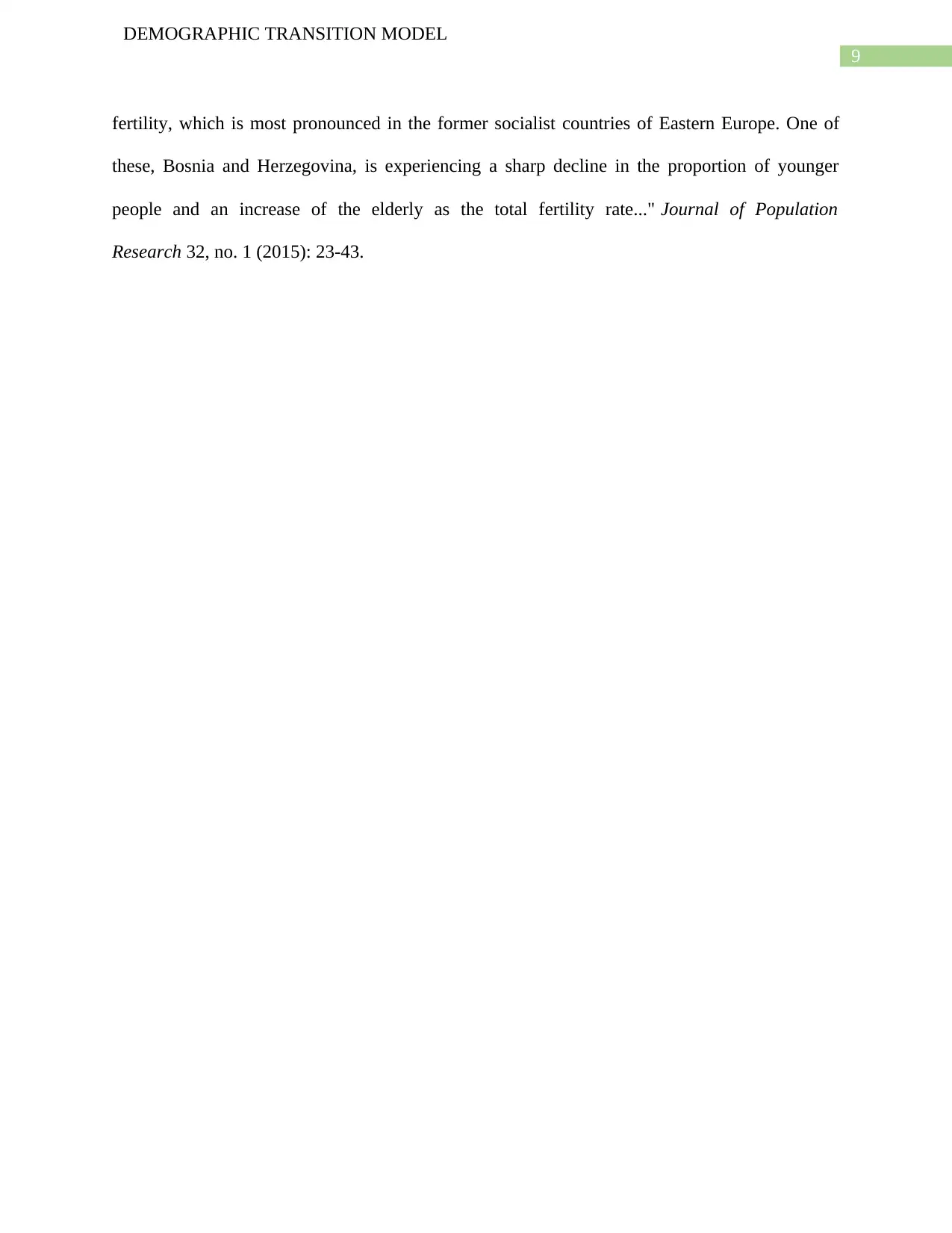
9
DEMOGRAPHIC TRANSITION MODEL
fertility, which is most pronounced in the former socialist countries of Eastern Europe. One of
these, Bosnia and Herzegovina, is experiencing a sharp decline in the proportion of younger
people and an increase of the elderly as the total fertility rate..." Journal of Population
Research 32, no. 1 (2015): 23-43.
DEMOGRAPHIC TRANSITION MODEL
fertility, which is most pronounced in the former socialist countries of Eastern Europe. One of
these, Bosnia and Herzegovina, is experiencing a sharp decline in the proportion of younger
people and an increase of the elderly as the total fertility rate..." Journal of Population
Research 32, no. 1 (2015): 23-43.
1 out of 10
Related Documents
Your All-in-One AI-Powered Toolkit for Academic Success.
+13062052269
info@desklib.com
Available 24*7 on WhatsApp / Email
![[object Object]](/_next/static/media/star-bottom.7253800d.svg)
Unlock your academic potential
Copyright © 2020–2025 A2Z Services. All Rights Reserved. Developed and managed by ZUCOL.





